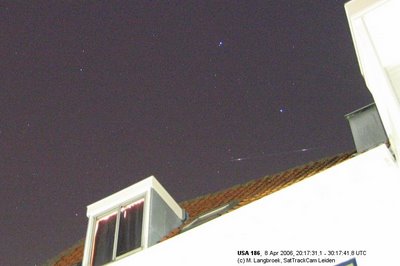
(click photo for full size image)
Yesterday evening was a fine clear evening again, with several interesting passes. I got treated with a nice set of Keyhole flares.
Most spectacular was USA 186 (2005-042A, #28888). I saw it and photographed it while it was producing two short brilliant flares of mag. -1.5 within 10 seconds while passing just below the tail of the Big Dipper. See the photograph above (30:17:46.8 should read 20:17:46.8, sorry for that typoe).
Next was another Keyhole, USA 129 (1996-072A, #24680), which produced a slow long flare up to mag. +0.5 in the N-NW at 21:11:10 +/- 5s UTC.
I got two good positions on USA 186, and one on USA129. In addition, I got two positions on the Japanese IGS 1B. With the latter I was lucky, as an untimely very local patch of clouds almost threatened to obscure it (see photograph below). It was very bright again at mag +1.5, while coming out of eclipse.
The points on both USA 186 and USA 129 agree very well in delta T and cross-track with the latest elsets for these satellites; however the points on IGS 1B are clearly off (0.1 degree) in cross-track compared to elset 06096.85488870 and I believe this is a true deviation, not a measurement error. These points are also some 2 seconds early.




